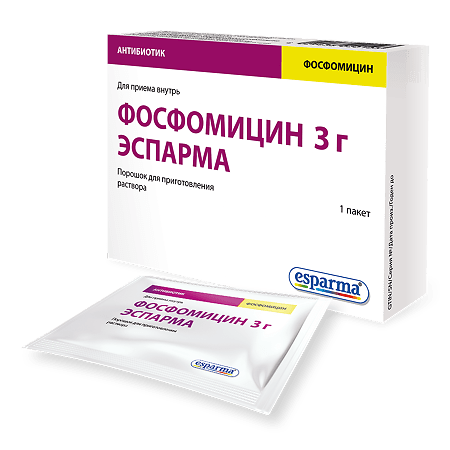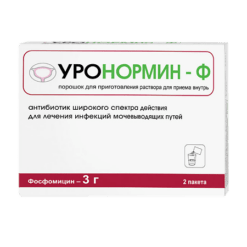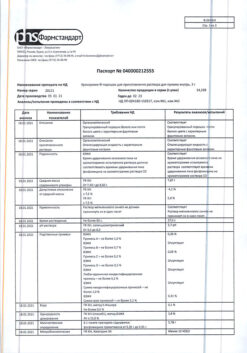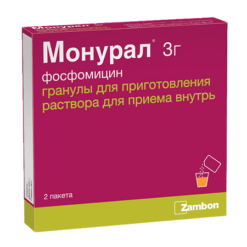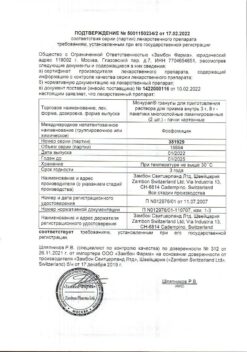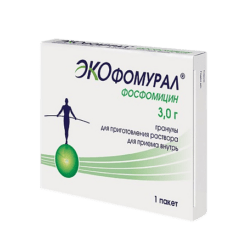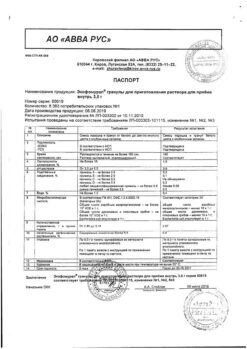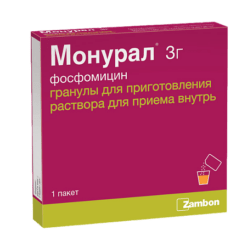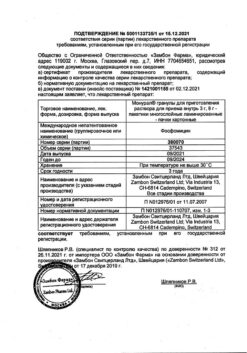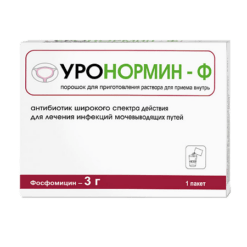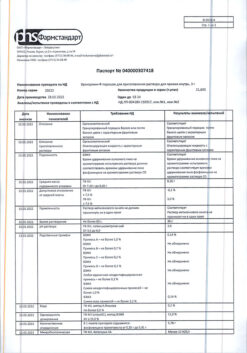No products in the cart.
Fosfomycin Esparma, 3 g
€16.72 €14.49
Description
Pharmacotherapeutic group
antibiotic
ATX code: J01XX01
Pharmacodynamics:
A broad spectrum antibiotic. It has a bactericidal effect. It is a structural analogue of pyruvate phosphoenol and penetrates into the microbial cell. The drug irreversibly inhibits the enzyme N-acetyl-glgocosamino-Z-ethylpyruvil-transferase irreversibly blocks condensation of uridine diphosphate-N-acetyl glucosamine with phosphoenolpyruvate inhibits the synthesis of UDF-N-acetylmuramic acid, thus inhibiting the initial stage of peptidoglycan formation in the bacterial cell wall.
Cross-resistance of the drug with other antibacterial agents is unknown. In vitro in combination with amoxicillin cephalexin pepemidine gold a pronounced synergism of antimicrobial action is noted.
In vitro to fosfomycin are sensitive Gram-positive (Staphylococcus saprophytticus nterococcus faecalis) and Gram-negative (Escherichia coli Klebsiella pneumoniea Citrobacter spp. Enterobacter spp. Proteus mirabilis) microorganisms. In vitro phosphomycin trometamol reduces adhesion of a number of bacteria to the epithelium of the urinary tract.
Pharmacokinetics:
Intake:
Osfomycin is moderately absorbed from the gastrointestinal tract when taken orally. In the body it dissociates into phosphomycin and trometamol. the oral availability of a single dose of 3 g ranges from 32 % to 54 %. maximum plasma concentration (C max) is observed 2-3 hours later (t max) after oral administration and is about 30 mg/l. The plasma elimination half-life varies from 3 to 4 hours.
Distribution:
Phosphomycin does not bind to plasma proteins is not metabolized preferentially accumulates in the urine. As early as 2-4 hours after oral administration of a single dose of 3 g, a high therapeutic concentration of 2-4 g/l is reached in urine, decreasing to 1-2 g/l after 6-12 hours. Mean concentrations after 12-24 hours and after 36-48 hours were 0.762 g/L and 0147 g/L, respectively.
The minimum inhibitory concentration (0128 g/l) of bactericidal for most urinary tract pathogens persists in the urine for at least 48 hours, necessitating treatment with a single dose.
Elimation:
The majority is excreted unchanged by the kidneys. A small portion is excreted through the intestine.
In case of moderate decrease in renal function, the half-life of fosfomycin Dots slightly lengthens, depending on the degree of functional impairment.
Indications
Indications
Active ingredient
Active ingredient
Composition
Composition
Powder for preparation of oral solution 1 sachet (8 g):
the active ingredient:
fosfomycin trometamol – 5.631 g (equivalent to 3 g of fosfomycin),
excipients: sucrose – 2.244 g; orange flavoring – 0.065 g; mandarin flavoring – 0.05 g; sodium saccharin – 0.01 g.
.
How to take, the dosage
How to take, the dosage
Orally.
Phosphomycin Esparma is administered once on an empty stomach 2-3 hours before or after a meal, preferably before bedtime after first emptying the bladder: in: tall people and children over 12 years old in a daily dose of 3 g. The contents of one sachet are dissolved in about 150-200 ml of water and taken immediately after preparation.
The course of treatment is 1 day.
To prevent urinary tract infections during surgical interventions and diagnostic procedures, the indicated dose is taken twice – 3 hours before and 24 hours after the intervention.
Phosphomycin Esparma should not be used in patients weighing less than 50 kg and in children under 12 years of age because the dose cannot be divided or reduced.
Interaction
Interaction
Simultaneous use with metoclopramide, antacids or drugs containing calcium salts may lead to decreased concentration of phosphomycin in the blood serum and urine. For this reason, it is recommended to take the drugs 2-3 hours apart.
Simultaneous use with other drugs that increase gastrointestinal motility may also lead to decreased concentration of phosphomycin in serum and urine.
Special Instructions
Special Instructions
The occurrence of acute and persistent diarrhea during or after antibiotic treatment can be a symptom of colitis caused by taking antibiotics. Pseudomembranous colitis is the most serious norm. In the case of pseudomembranous colitis, appropriate measures must be taken immediately. In such a case, the use of drugs that slow down peristalsis is contraindicated.
The drug contains sucrose. Patients with rare hereditary diseases, fructose intolerance, glucose-galactose malabsorption or insufficiency of sucrose isomaltase should not take this medicine.
One packet of Fosfomycin Esparm contains approximately 2.3 g of sucrose, which is equivalent to about 0, 19 bread units (BE).
The concomitant ingestion of nisha slows the absorption of the pellets, so it is recommended that the drug be taken on an empty stomach, 2-3 hours before or after a meal.
Patients should be advised of the possibility of dizziness and should refrain from performing the indicated activities if dizziness occurs.
Contraindications
Contraindications
Hypersensitivity to phosphomycin or other ingredients of the drug;
severe renal impairment (creatinine clearance < 20 ml/min);
Children younger than 12 years of age because there are insufficient data on its use;
sugarase/isomaltase deficiency;
Side effects
Side effects
By frequency of occurrence, side effects are in the following groups:
Very frequent: (> 1/10)
Frequent: (> 1/100-< 1/10)
Me frequent: (> 1/1.000-< 1/100)
Rare: (> 1/10,000-< 1/1.000)
Very rare: (< 1/10,000)
Unknown: (frequency of adverse events is not determined based on existing data).
Drinking system side:
Frequent: headache dizziness asthenia
Not frequent: sensation of numbness of the skin “creeping goosebumps” paresthesia
Unknown: optic neuritis
Cardiovascular system disorders:
Rare:Tachycardia
Unknown: decreased blood pressure
Respiratory system of the chest and mediastinum:
Unknown: bronchial asthma
Immune system disorders:
Unknown: skin itching anaphylactic shock hypersensitivity reactions (angioedema skin rash urticaria)
Gastrointestinal tract disorders:
Infrequent: diarrhea nausea dyspepsia
Rare: vomiting
Unknown: pseudomembranous colitis abdominal pain
Hepatic and biliary tract disorders:
Not frequent: increased “hepatic” transaminase activity
Genital and mammary tract disorders:
Not frequent:vulvovaginitis
Blood and lymphatic system disorders:
Not frequent: thrombocytosis leukopenia
If any of the side effects listed in the instructions worsen or if you notice any other side effects not listed in the instructions, tell your doctor.
Overdose
Overdose
Symptoms of overdose: vestibular syndrome, hearing impairment, “metallic” taste and general taste disorders, diarrhea. No specific antidote has been identified.
If necessary, symptomatic treatment is administered.
Pregnancy use
Pregnancy use
In pregnancy, use only if the estimated benefit to the mother exceeds the potential risk to the fetus.
If the drug is prescribed during lactation, breastfeeding should be stopped for the duration of treatment.
Similarities
Similarities
Additional information
| Shelf life | 3 years. Do not use after the expiration date printed on the package. |
|---|---|
| Conditions of storage | At a temperature not exceeding 25 ° C. Store out of the reach of children. |
| Manufacturer | Lindopharm GmbH, Germany |
| Medication form | Powder for preparation of solution for oral administration |
| Brand | Lindopharm GmbH |
Other forms…
Related products
Buy Fosfomycin Esparma, 3 g with delivery to USA, UK, Europe and over 120 other countries.

